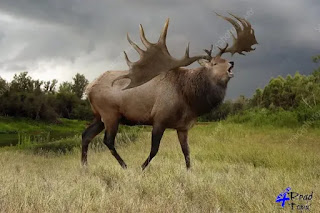Irish Elk
Irish elk are extinct individuals of the Cervidae household that died off about 7,700 years ago. It used to be one of the greatest deer species to ever stroll the earth. Their essential defining attribute used to be their widespread antlers, which dwarfed these of current deer, elk, and moose.
Despite their name, Irish elk did not just live in Ireland, nor were they related to elk. Read on to analyze the Irish elk.
- Description of the Irish Elk:
Though no one is alive nowadays has ever viewed one in the flesh, the fossilized stays of this species supply us with a precise estimation of what they are regarded like. They stood about 7 ft. tall at the shoulder, and their antlers had been 12 ft. across
To lift such heavy antlers, it is probably they had been quite muscular, specifically in their necks, chests, and backs. Scientists estimate that they weighed about as many tons as some present-day moose, up to 1,500 lbs.
- Interesting Facts About the Irish Elk:
These elk have attracted us, humans, for ages because they have the largest antlers of any creature. While we don’t recognize the entirety there is to understand about these mysterious creatures, we do comprehend a few exciting facts!
- Why do we still call these enormous cervids "Irish" elk? Why do we still refer to these enormous cervids as "Irish" elk although we know they were not exclusively found in Ireland? Paleontologists have observed a couple of stays of well-preserved Irish elk in the course of peat toilets and lakes in Ireland. This is no longer the sole region they are discovering fossils, however, the identity is stuck!
- Because of this, they are existing in the folklore and artwork of pretty a few unique regions.
- Awesome Antlers – This deer had the biggest antlers of any different deer species. Their huge antlers measured 12 ft. throughout and weighed up to eighty lbs. or more! Their antlers have been palmate, or palm-shaped, like current moose. However, the tines, or points, of the antlers have been longer than these of moose.
- Habitat of the Irish Elk:
Scientists trust that this species lived in open grasslands. Logistically speaking, strolling thru forests with 12 ft. antlers would have been a nightmare.
They in all likelihood required loads of vegetation to hold their substantial physique measurement as well. As with any extinct animal, researchers can solely speculate the precise small print of this animal’s needs.
- Distribution of the Irish Elk:
Because they are extinct, scientists can't say with a sure bet in all places that these deer lived. Fossilization requires particular sorts of conditions, so it is in all likelihood that these deer lived in different areas and specimens sincerely decayed as usual, as a substitute of present process preservation.
Researchers accept as true that they lived at some stage in lots of Europe, northern Asia, and northern Africa. They lived in many of the identical areas that historical human beings did.
- Diet of the Irish Elk:
There is honestly no way to understand for certain what these large elk ate whilst they lived. Scientists can solely speculate their weight loss plan based totally on comparable animals and the habitats they lived in.
Like most different individuals of the Cervidae family, you can count on these elk who have been herbivores. They possibly ate grasses, leaves, stems, shrubs, herbs, fruits, and any different comparable vegetation.
- Irish Elk and Human Interaction:
Because these massive deer lived at the equal time as humans, for at least the stop of their reign, researchers expect that human beings hunted them. However, they are not sure whether or not searching contributed to the extinction of this species.
Various scientists range in opinion, however, most agree that the decline of choicest habitat after the preceding Ice Age, as properly as introduced strain from hunting, ended this species. As mankind continues to destroy ecosystems and hunt certain animals to extinction, this serves as an effective warning tale, similar to the demise of many other species.
- Domestication:
Humans by no means domesticated Irish elk.
Is Keeping an Irish Elk as a Pet Plausible?
This species is extinct, so it is not possible to personal one as a pet. However, even if they have been alive, preserving an animal with 12 ft. antlers as a pet would be inadvisable. It really couldn’t be a residence pet, in fact, it couldn’t even healthy thru your the front door!
- Irish Elk Care:
Because this elk species is no longer extant, researchers are unsure what type of treatment they might prefer in a zoological environment. We can count on this species due to the fact it is pretty comparable in measurement and structure to moose, would want comparable care.
As ways as their diet, behavior, and breeding habitats, we surely can't recognize what is optimal. As with any extinct animal (that is now not these days extinct), some matters truly continue to be a mystery.
- The conduct of the Irish Elk:
While there is no concrete proof, scientists agree that these elk used their large antlers to conflict one some other for breeding rights. As with different species of deer, these elk possibly lived in herds.
Males in all likelihood used their big antlers to combat dominance and the proper to breed with females. In addition, they probably used their extensive antlers to protect themselves and their herds from predators.





Comments
Post a Comment
You can write your comment here